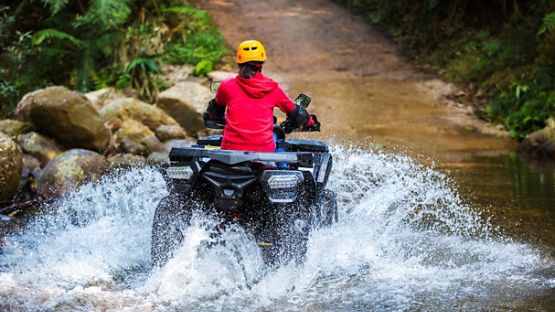As cold weather approaches, preparing your car for the winter season becomes essential. Canada is known for its harsh winter weather, and ensuring your vehicle is ready can make a significant difference in both safety and performance.
In this blog post, we'll explore various tips on how to winterize your car, ensuring it's ready for whatever winter driving challenges may arise.
Key takeaways
- Schedule a winter service for your vehicle to check essential systems like the battery, brakes and cooling system to ensure they're ready for cold weather.
- Switch to winter tires for better traction and handling in icy conditions, and maintain proper tire pressure to enhance safety.
- Maintain at least half a tank of gas to prevent fuel line freeze and ensure you’re prepared for delays in winter driving.
- Assemble a winter-specific emergency kit that includes a first aid kit, jumper cables, warm clothing and non-perishable food to stay prepared for unexpected situations.
1. Schedule a winter service
One of the first steps in preparing your car for winter is to schedule a winter service. A thorough inspection can help identify potential issues before they become problematic in icy conditions.
Key components to check
During your winter service, ensure the following components are thoroughly inspected:
- Battery: Cold temperatures can impact battery power. Check for corrosion and ensure the battery is holding a charge.
- Cooling system: A well-functioning cooling system is key to preventing overheating during winter months. Have the coolant levels checked, and make sure they’re appropriate for low temperatures.
- Brakes: Ensure your brake system is in optimal condition, as stopping distances can increase on icy roads.
- Wiper blades: Winter wiper blades are designed to handle snow and ice better than regular wipers. Consider switching to these for improved visibility.
- Cabin air filter: A clean filter ensures warm air circulates effectively inside the vehicle, helping you stay warm during chilly drives.
Scheduling a tune-up is also recommended to ensure all components are functioning correctly, including the charging system, exhaust system and fuel lines.
2. Switch to winter tires
Winter tires, often referred to as snow tires, are specifically designed to perform better in cold weather conditions compared to all-season tires. The rubber compounds and tread patterns in winter tires provide better traction and handling on icy roads.
Why winter tires matter
- Better traction: The specialized tread pattern allows for improved grip in snow and slush, reducing the risk of sliding.
- Legal requirements: In some parts of Canada, using winter tires is mandatory during the winter months. Be sure to check local regulations to ensure compliance.
- Optimal performance: Winter tires remain flexible in low temperatures, providing better contact with the road surface, which enhances safety and performance.
Investing in a set of winter tires is one of the best ways to ensure safe winter driving. Make sure to check the tire pressure regularly, as every time the temperature drops 10 degrees Celsius, a tire loses approximately one PSI of air pressure.
3. Maintain proper tire pressure
As cold weather arrives, maintaining proper tire pressure is important. Low tire pressure can lead to reduced traction and increase the risk of blowouts.
Tips for monitoring tire pressure
- Regular checks: Use a reliable tire pressure gauge to check the pressure at least once a month during the winter.
- Follow manufacturer's guidelines: Refer to your vehicle owner’s manual for recommended tire pressure levels.
- Stay alert for changes: Keep an eye on tire pressure, especially after significant temperature drops.
If you notice a tire is consistently low, consider visiting an auto parts store for inspection or repair.
4. Install winter wiper blades
When preparing your car for winter, don't overlook the importance of your windshield wipers. Installing winter wiper blades can significantly enhance visibility during bad weather conditions.
Advantages of winter wiper blades
- Ice resistance: The rubber used in winter wiper blades is designed to prevent ice from accumulating, ensuring a clear windshield.
- Improved performance: These blades are typically heavier and better suited for removing snow and slush.
Remember to remove your winter wiper blades in the spring, as they are heavier than standard blades and can put extra load on your wiper motor.
5. Keep washer fluid topped up
Visibility is paramount while driving in winter conditions. To maintain a clear view, keep your windshield wiper fluid topped up with a winter-specific formula.
Tips for ensuring visibility
- Use the right fluid: Opt for washer fluid that is designed for winter conditions, as it remains effective even in freezing temperatures.
- Regular checks: Make it a habit to check your fluid levels every week during the winter season..
- Carry extra fluid: Keeping a spare bottle in your trunk can save you from being caught without visibility during a snowstorm.
6. Assemble a winter-specific emergency kit
Preparing an emergency kit can be a lifesaver during the winter months. Having essential items in your vehicle can help you handle unexpected situations.
Essential items to include
Your winter emergency kit should include the following:
- First aid kit: Ensure it is fully stocked to handle minor injuries.
- Jumper cables: These can help you get a boost if your battery fails.
- Non-perishable food and water: Keep snacks and bottled water handy for emergencies.
- Warm clothing and blankets: Dress in layers and have extra clothing available to stay warm if you get stranded.
- Flashlight and flares: These can be critical for visibility during emergencies.
- Shovel and bag of sand: A shovel can help clear snow, while sand can provide traction if you get stuck.
For more detailed recommendations, check out this post on car emergency kits.
7. Keep winter tools handy
In addition to your emergency kit, it’s important to have tools ready for winter driving. Here are a few essential tools to keep in your vehicle:
- Snow brush: A sturdy snow brush will help clear your vehicle of snow before you drive.
- Ice scraper: Make sure to have a reliable ice scraper for your windshield.
- Extra windshield wiper fluid: Having extra on hand is important, especially in bad weather conditions .
Being prepared can save time and hassle when dealing with winter's challenges.
8. Monitor your gas tank
Maintaining an adequate amount of fuel in your gas tank can provide extra peace of mind during the cold weather.
Why it's important
- Preventing fuel line freeze: Keeping your tank at least half full can help prevent fuel lines from freezing.
- Being prepared for emergencies: In case you get stuck in traffic or encounter delays due to weather conditions, having enough fuel can keep your vehicle running.
9. Check your battery
A weak battery can leave you stranded during the winter season. Cold temperatures can significantly reduce battery performance, so it’s vital to have your batteries checked regularly to ensure it’s in good shape.
Tips for battery maintenance
- Test the battery: Have it tested during your winter service to ensure it’s holding a charge
- Inspect connections: Check for corrosion or loose connections that could impact battery performance
- Consider synthetic oil: Using synthetic oil can help your engine start more easily in cold temperatures
10. Prepare your heating system
Commuting in winter weather means relying heavily on your vehicle's heating system. Have your heating systems thoroughly checked to ensure that everything is functioning correctly before the cold weather arrives.
Key components to check
- Blower motor: Make sure the blower motor is working effectively to circulate warm air throughout the cabin
- Heater core: Check for leaks and ensure it is providing adequate heat
Be aware of carbon monoxide poisoning
Have a professional ensure that your exhaust system is in good condition to prevent any risk of carbon monoxide poisoning. Check for leaks or blockages that could impact the safe operation of your vehicle.
Wrapping up: Stay safe and prepared
Preparing your car for winter is important for safe driving during the winter months. From winter tires to an emergency kit, taking the time to winterize your car can significantly improve your safety on the road.
Remember to regularly check your vehicle's essential systems, maintain proper tire pressure and keep your fuel tank full. With the right preparation, you can confidently navigate the challenges of winter driving.
For additional information on vehicle insurance coverage during the winter season, consider reviewing your policy details. Stay safe and prepared this winter.













